This post may contain affiliate links.
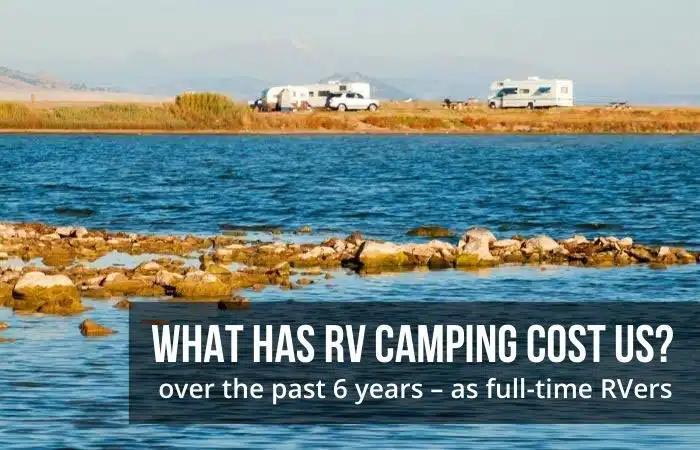
RV camping is one of the biggest expenses for any RVer. So exactly how much did we spend on camping during six years as full-time RVers traveling North America? We’ve done every kind of RV camping – from RV parks to boondocking – and tracked the costs. Then calculated our average nightly camping rates, year over year.
This detailed article is a follow-up to our last post, where we did a comprehensive review on our Thousand Trails camping membership, where we covered how much it cost and how much money it saved us.
Update: The Thousand Trails comprehensive review mentioned above has now been updated to include ten years of a mix between full-time and part-time RVing use.
This is all part of our 6-year recap series, where we take an in-depth look at what our full-time RV lifestyle cost us during the first six years.
Quick Links to Sections of This Article
- Introduction – before we dive in
- What factors affect camping rates?
- Where do we camp in our RV?
- Where have we been?
- What has our RV camping cost us over the past 6 years?
- How much did our Thousand Trails membership cost?
- What did our off-grid solar and battery system cost?
- Our boondocking nightly camping cost?
- Why boondocking isn’t really free
- Annual breakdown of our RV camping stays and costs (2014-2020)
- Final Overview and Comments
- Recommended RV Camping Resources

Before we dive into RV camping costs
While we tracked our annual camping expenses since we began RVing, we never got around to doing annual summary blog posts. However, we did an overall annual snapshot of our RV life expenses for the years 2015 and 2016. How and where we camp and what we pay for it changes. After six years of full-time RV travel, we feel this article provides a good overview of how it averaged out over time.
For the record, we are not suggesting that our RV camping expenses are typical. We know many RVers who spend way more than we do on RV camping and others who spend way less. Everyone RVs differently.
But in this article, we share OUR personal experience. The ways WE like to camp evolved over the years. We hope that giving some more insight into our RV travel style and expenses will provide you with a useful guide as you plan and budget for your own RV travels!
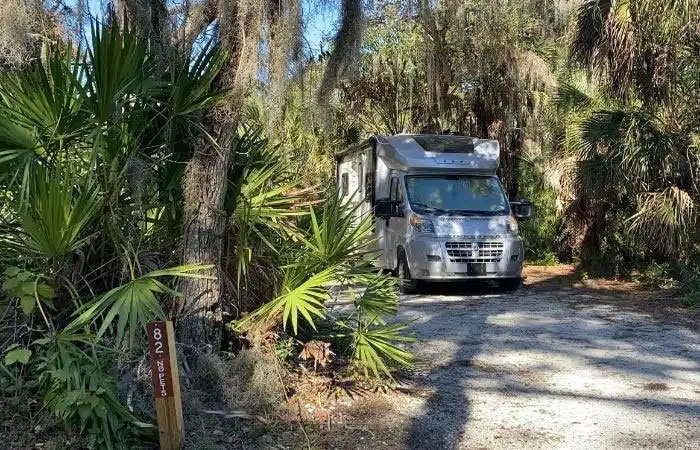
Staying in a water-electric site at Oscar Scherer State Park in our Florida rental RV
What factors affect RV camping rates?
First up, it’s important to know that RV camping costs depend on many factors, including:
- Where you stay – geographic location, type, campground standard, and amenities.
- When you stay – during peak season, holidays, or off-season.
- How you stay – campground with hookups or boondocking off the grid.
- How long you stay – overnight, for a week, month, season, or year-round.
- Camping memberships – access various discounts and savings.
- Your RV – the type of RV, size, power needs, and other amenities (e.g., sewer).
These have all been factors in how much and little we have spent on RV camping over the years.
So keep in mind that your choices will affect what you spend too, and your expenses may vary widely from what we have shared here.
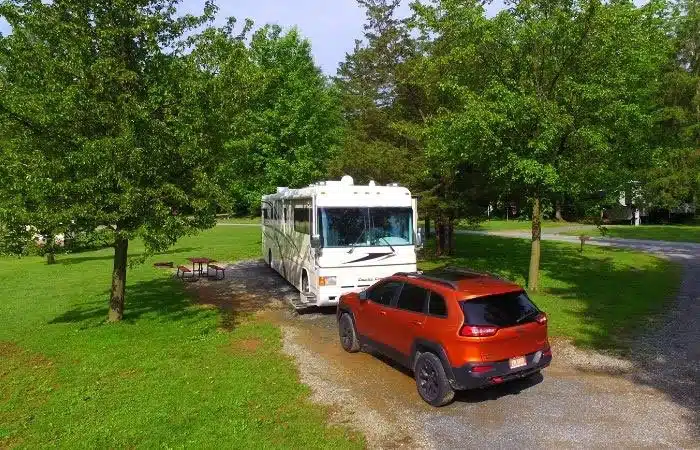
Campsite at Hershey RV and Camping Resort, Pennsylvania – Thousand Trails campground
Where do we camp in our RV?
To put all of our RV camping expenses in context, let’s start with an overview of the many types of RV camping we enjoy. We know some RVers who almost exclusively stay in RV parks, campgrounds, and RV resorts. And others who almost exclusively boondock, off the grid without hookups. Some like Wal-docking (staying overnight in Walmart parking lots) or truck stops, while others snub it.
But we like the best of ALL worlds. The variety, flexibility, and freedom of the many different kinds of RV camping make the lifestyle so fun for us. So we mix and match, depending on our needs and goals at any given time.
Here is an overview of the types of places we typically camp in our RV:
- Private RV parks and membership-based campgrounds. We try to stay in Thousand Trails as often as possible to save money.
- RV resorts (sometimes upscale or luxury resorts).
- National park and state park campgrounds (if we can get a reservation and find a site to fit our RV).
- Local city park campgrounds and fairgrounds.
- Walmart, Cracker Barrel, Cabela’s, Bass Pro Shops, and the occasional rest stop (for an overnight stay to break up a long-haul drive).
- RV repair centers (as needed).
- Harvest Hosts (such as wineries and farms).
- Boondockers Welcome (for short stays with private hosts).
- Boondocking (on BLM land, National Forest, or other open land).
- Moochdocking (boondocking with partial or no hookups on a friend’s property).
- RV rallies and special events.
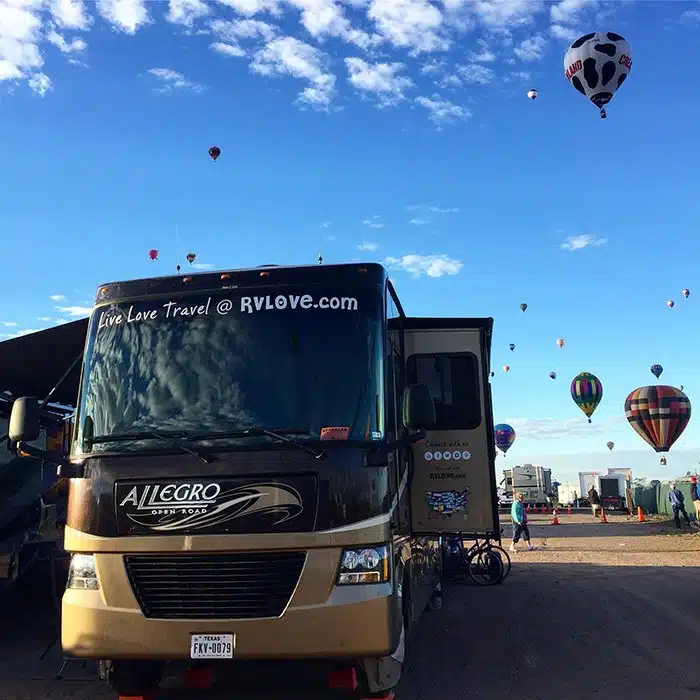
Where have we been?
Geographically, we have visited all 50 USA states, 48 of them with our RV. So our RV camping costs are based on visiting the entire country, not just a particular region. We have visited popular touristy areas at peak times, quiet rural towns, and many places during shoulder and off-peak times too.
So we feel the data we share here and the average nightly cost paints a pretty good overall picture of what you might be able to expect. That is IF you camp in a similar way to us!
What about other travel?
We typically also like to do other types of travel – like air travel, hotels, and cruises. That means some years, we’ll spend money on RV storage while we’re out of our RV. This is in addition to our non-RV-related travel costs.
But in this article, we’re sticking to RV-related camping costs only!
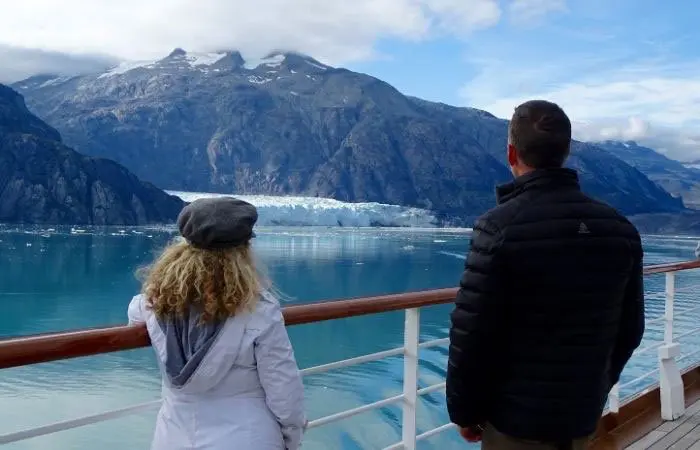
Gazing at glaciers from our Alaskan cruise ship
Related Articles
- Our first boondocking experience – recap on usage and costs
- 2015 RV Expenses Snapshot
- 2016 RV Expenses Snapshot
- Campground and RV Park Reviews
- Part 1: 5 Years of Full-Time RV Living – Decisions, Mistakes, Regrets, Highlights
- Part 2: 5 Years of Full-time RV Living – Top 5 Travel Highlights, Challenges and Personal Experiences
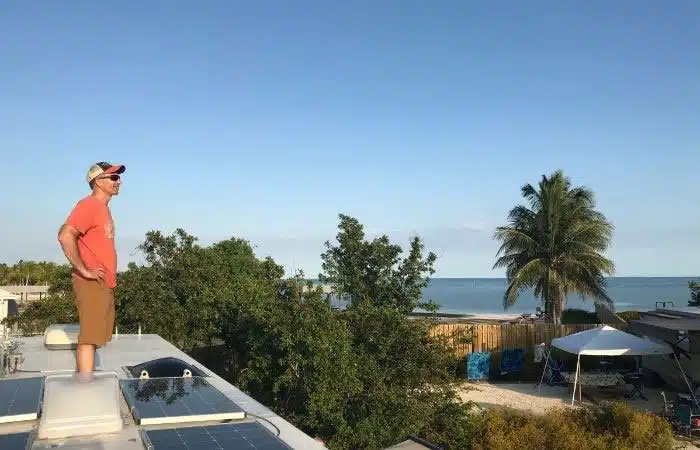
Water views from the top of our RV at Curry Hammock State Park, Florida
So, what did our RV camping cost us over 6 years?
First, Let’s dive into the total cost of our full-time RV camping. Then break it down for you to provide more context and detail on HOW we camped each year.
- Total RV camping expenses over six years of full-time RV travel = $34,145
- Annual average = $5,690 per year
- Monthly average = $474 per month
- Daily average = $16.63 per night (based on 2014-2020 annual averages)
The most we paid for a campground during these six years was $146 at Boyd’s of Key West in March 2019. Our lowest nightly fee was $10 at Pioneer Park in Wellington, TX. And, of course, most (not all) boondocking is free.
How much do camping sites cost?
When you consider that an average campground nightly stay ranges between about $35 – $55 a night these days, we feel that our average turned out to be pretty good. Even being extremely conservative and estimating a nightly camping fee of $30, we still came in at just over half of that. Not bad for ‘living the dream’ and traveling while still working, eh?
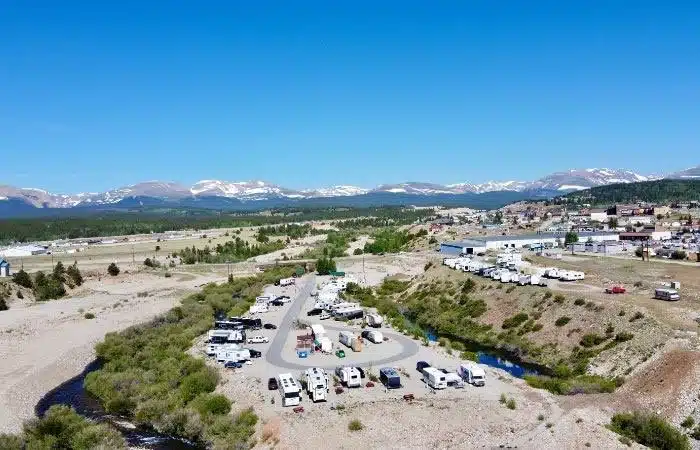
Riverside campsite, mountain view campsite at Middlefork RV Park, Fairplay, CO
How did we save on our nightly RV camping costs?
We have a few camping memberships that have helped us save on camping fees. But the two biggest factors that contributed to our overall campground savings are:
- Our Thousand Trails membership. We purchased a Zone Camping Pass before we hit the road in 2014. Then upgraded our membership a few months later.
- Our off-grid system with lithium batteries and solar panels. Installing this system in May 2018 enabled us to boondock more extensively and comfortably.
Keep in mind both of these were considerable investments. Sometimes you need to spend money to save money. Other camping memberships we’ve utilized occasionally include Passport America, Harvest Hosts, and Boondockers Welcome.
But let’s be clear about which of these expenses are included here in our total RV camping costs and which ‘bucket’ we put them into.
RV camping costs included In this article:
- We HAVE included the cost of all our RV camping stays.
- We HAVE included the cost of purchasing our Thousand Trails membership(s) and annual dues. Thousand Trails was specifically a camping-related purchase.
- Also, We HAVE included the cost of all our other RV camping memberships
- We HAVE NOT included the cost of our off-grid system. While we love it, we do NOT consider an off-grid system like the one we have to be essential to RV boondocking. Rather, we consider this an optional RV mod/upgrade that increased our comfort, convenience, and the value of our motorhome. Check out our separate, detailed RV ownership post about six years of RV mods, financing, repairs, and maintenance here.
- Included stays at no hook-up campgrounds, such as national parks with a nightly fee, as PAID camping (even though we camped off-grid)
- Considered boondocking, for the purpose of this article, as not being plugged into utilities (specifically power) and NOT paying for our stay. For example, camping on most BLM land, mooch docking, overnighting at a Walmart, Cracker Barrel, or rest stop, and staying at a Harvest Hosts location.
So now you’re wondering, what does all this cost!?
It all varies depending on your needs, but let’s give you a high-level ballpark overview before we go more granular.
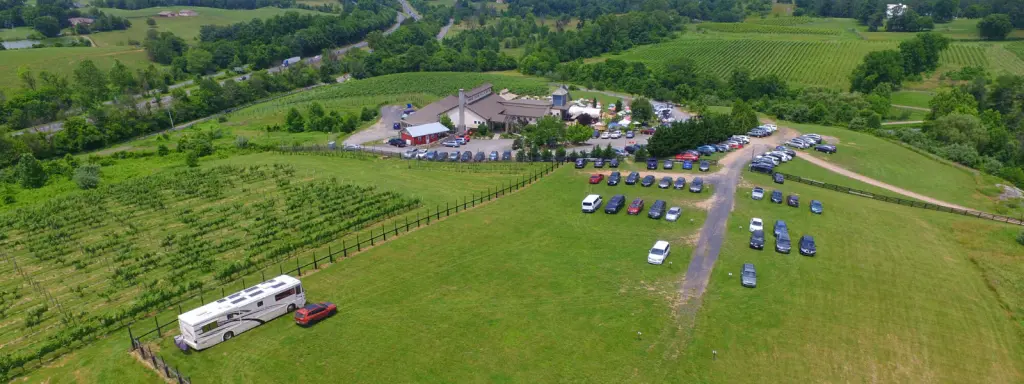
Boondocking at Barrel Oak Winery in Virginia, thanks to Harvest Hosts
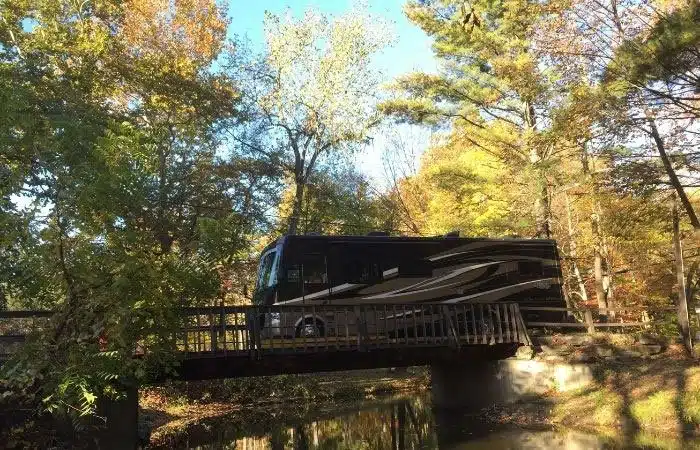
Crossing the bridge into Thousand Trails Rondout Valley RV Campground in Accord, NY
What did our Thousand Trails membership(s) cost?
We covered this in detail in our last blog post. But if you missed it, in a nutshell, we spent a total of $7,242 over the six years on Thousand Trails. That included purchasing a Zone Camping Pass, upgrading to an Elite membership, the Trails Collection, plus annual dues.
You can literally spend anywhere from about $600 to $18,000 on a Thousand Trails membership. There are many different kinds to choose from, with varying levels of member benefits.
Keep in mind that what worked for us may not work for you. So we recommend you learn more by reading our other TT articles that cover the options and membership pricing.
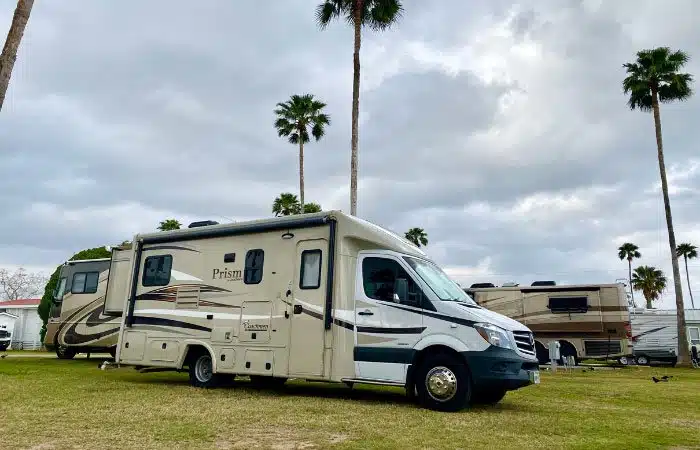
Campsite at Fun n Sun RV Resort, Rio Grande Valley, TX (Trails Collection) in our rental RV
What was our nightly camping cost at Thousand Trails?
When we divided the $7,242 we spent on Thousand Trails over six years by the 823 nights we spent in the TT system; we ended up paying an average of $8.80 per night at Thousand Trails campgrounds.
As you might expect, Thousand Trail’s prices have increased since we bought our membership(s) way back in 2014. So if you plan to use Thousand Trails as extensively as we have, you will want to budget at least $600 to get started with a Zone Camping Pass (as we did).
If you want to upgrade your membership for more options (e.g., for full-timers / extended travelers) you will most likely want an Elite membership or something with similar benefits. Most people spend somewhere between $3,000 – $8,000 on a Thousand Trails membership upgrade, depending on the membership type and whether they buy new or used/resale. Each option has its merits. There is no one ‘best’ membership.
Learn more about our Thousand Trails camping membership in these articles
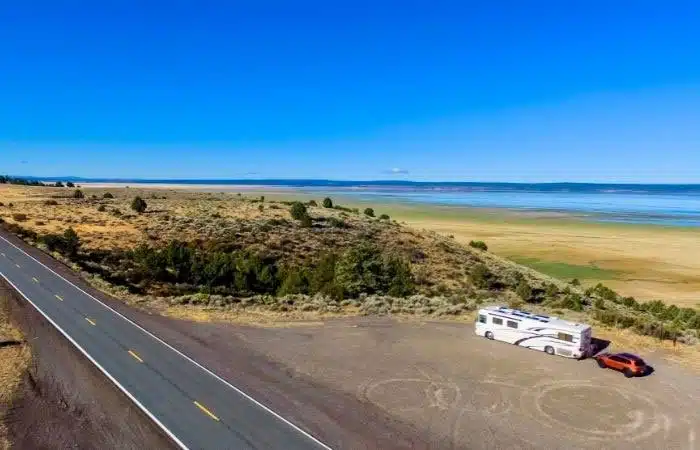
We boondocked overnight at this roadside pullout by Goose Lake, near the OR/CA border
How much was our off-grid solar and battery system?
The retail price of a really robust system like the one we installed in our 40’ Class A diesel pusher motorhome would cost close to $15,000, including parts and professional installation.
But don’t worry. You don’t need to go that big in order to be able to boondock! If you have a smaller RV or lower power needs and desires, you could definitely boondock with a much less powerful and less expensive system. Or even invest in a generator.
Do you need solar?
It is worth noting that we didn’t make ANY solar or battery upgrades to our RV in our first three years of RVing. We boondocked in our first motorhome just as it came from the factory – with the house batteries, generator, and a portable 12-volt inverter to charge our electronics. That all worked just fine.
In fact, it took us two years and nine months to get around to spending a few hundred bucks on a 100-watt portable solar panel! This is the portable solar panel we have – we did a video review on it here. This was a great, low-cost way to get started with solar.
When we first considered upgrading to a big off-grid system for our first RV in 2014, we did the math and felt we would get more value out of a Thousand Trails membership upgrade than a solar/battery upgrade system. And we did! Our first RV actually had a weight problem. So we waited until we got an RV with more cargo-carrying capacity before getting a big solar and lithium battery setup in 2018.
Here is what our solar and battery system includes:
- 600ah of lithium batteries by Battle Born Batteries
- 1,020 watts of roof-mounted solar panels by Zamp Solar
- 3,000-watt Victron Hybrid Inverter
- Victron Solar Charge Controller
- Victron Color Control Battery Monitoring System
Disclosure: our off-grid setup was installed as part of a project/partnership with Battle Born Batteries and Zamp Solar. This was a complex, multi-day job install into our motorhome, with a team of experienced full-time RVing friends helping us. So we did not incur any labor costs. Our actual out-of-pocket expenses for this system were about $2,000.
We absolutely love the freedom offered by our off-grid system. But it’s important to remember that most people simply don’t need a big setup like we had. So don’t feel like you have to go all out like this in order to boondock. A system like this is nice to have, not a must-have. But it’s great for those who want to have serious boondocking capability for extended periods of time.
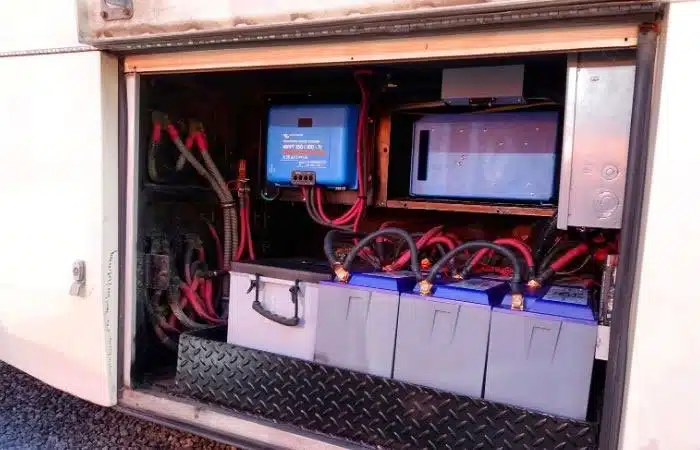
Our off-grid system with 600 amp hours of lithium batteries and 1,020 watts of solar panels
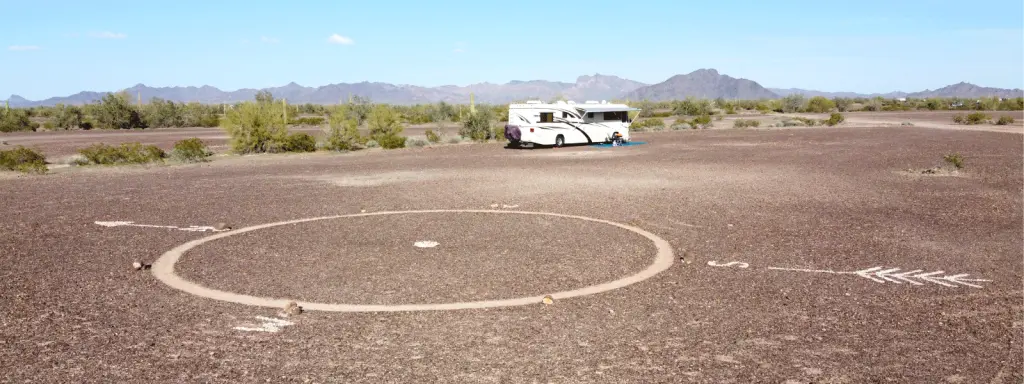
Boondocking in the Arizona desert for five weeks during the pandemic lockdown was easy for us
How much was our boondocking nightly cost?
When we boondocked in our previous motorhome with the onboard factory options like generator and propane (two lead acid batteries, no solar, no inverter), we estimated our nightly boondocking cost was around $10 a night. It could have been lower, but we often ran the generator to power our computers so we could work. You can read more about our first boondocking experience, usage, and costs (2015) here.
But let’s look at the difference our 2018 power system upgrades made. When you divide the value* of our current off-grid system (approx. $15K installed) by the number of nights we spent boondocking with it (260), the average expense works out to be $58 a night. That is based on 260 nights of boondocking SO FAR. That is from the installation in May 2018 up to the point of putting this article together at our 6-year mark in June 2020.
The cost would come down over time
Remember that this system was a one-time upgrade done a little over two years ago. Therefore, the more time we continue to spend off the grid in the years to come in this RV, our average nightly expense will continue to decrease. In our opinion, it really only makes sense to invest heavily in a significant off-grid system like this if you plan to keep your RV for quite a while and use your off-grid system a lot.
Of course, the more you use it, the more you will save on RV camping fees over time. And some buyers might value the upgrades, which could off-set the cost when selling. But not all buyers value power upgrades.
*Note: the majority of our off-grid system was provided within a partnership project in conjunction with Battle Born Batteries and Zamp Solar Panels.
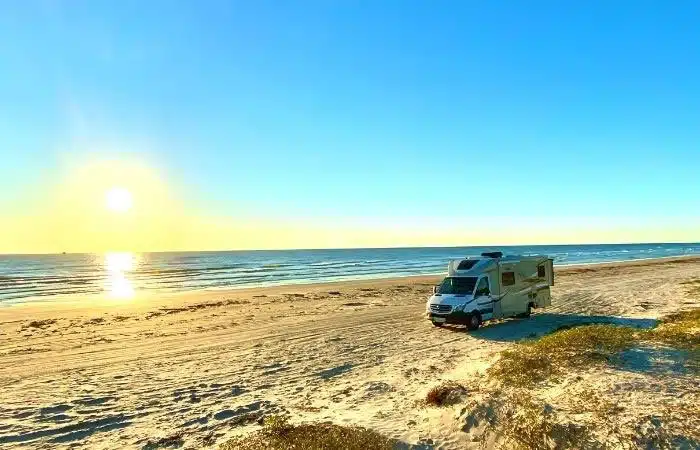
Beach camping on North Padre Island, Texas in a rental RV, using the on board generator
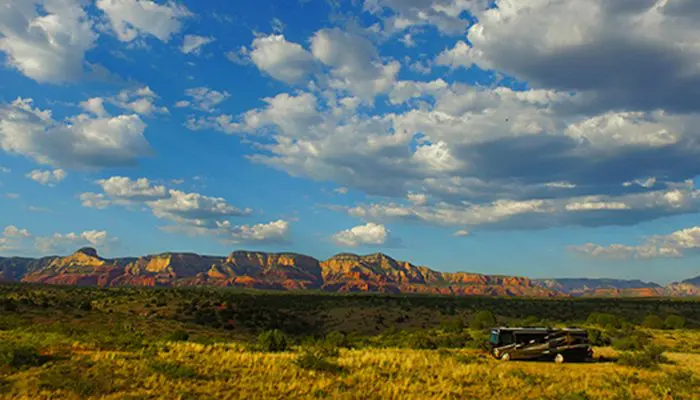
Boondocking in Sedona, Arizona with our first motorhome, using the generator and a 100w portable solar panel
Boondocking isn’t really ‘free’
We want to highlight an important point here. People always say boondocking is ‘free’. But that’s not exactly true. You can boondock in your RV straight from the factory without buying additional equipment. But there are still other costs to consider when boondocking:
- Generally, you still need to spend money (sometimes) to dump and fill your tanks somewhere.
- Sometimes even National Forest or BLM land, which are typically free, may charge a nightly fee for camping.
- It costs money to buy a generator unless your RV comes equipped with one. And it costs money to put fuel in the generator.
- Propane costs money for your water heater, cooking, furnace, fridge, etc.
- You may need to pay for fresh water at a nearby campground unless you can find a free, safe (and legal) water source.
- If you decide to invest in solar panels, additional and/or upgraded batteries, and other equipment, you’ll also need to budget for those.
Also, consider the kinds of roads and terrain you will need to access to camp off-grid. They tend to be harder on your RV and tow vehicles than driving on highways and in campgrounds. So you might want to factor in the cost of extra wear and tear on your RV and tow vehicle when accessing these off-grid roads. How do we know this? Check out our Boondocking Misadventures in Lake Havasu post and video to find out!
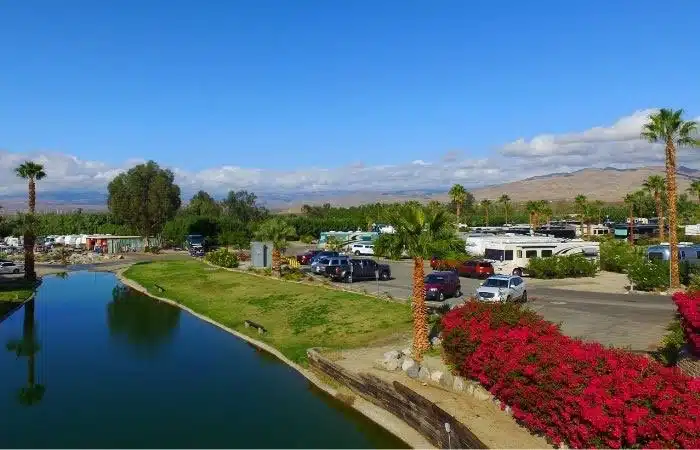
Snowbirding in the winter at Catalina RV Resort and Spa, Desert Hot Springs, CA
Annual Breakdown of RV Campground Stays / Expenses
Let’s dig a little deeper into the data, to see how and where we stayed each year. All while traveling the country in our RV, between June 2014 and June 2020.
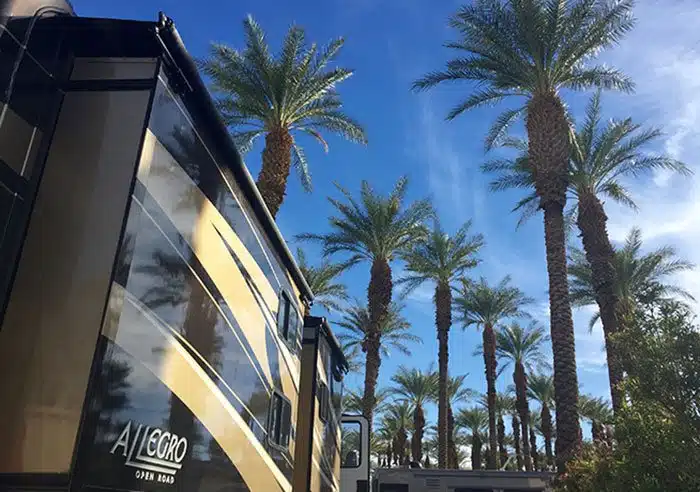
We’ve spent many winters at Thousand Trails Palm Springs RV Resort, Palm Desert, CA
2014 RV Camping Costs (mid-June – end December)
We spent most of 2014 visiting the northwest and southwest USA – California, Oregon, and Washington. During our first seven months on the road, we visited seven states and drove the RV about 4,500 miles.
We RV camped for a total of 208 nights and paid an average of $24 per night. This includes the purchase price of our Thousand Trails Zone Pass (April 2014) and our upgraded TT Elite membership (September 2014), plus stays at private RV parks. We also had camping memberships with Boondockers Welcome and Harvest Hosts.
Here’s the breakdown of how and where we camped:
- 151 nights at Thousand Trails campgrounds.
- 18 nights at private RV parks and campgrounds.
- 16 nights at public campgrounds (national and state parks).
- 12 nights of boondocking (Walmart, rest stops, Harvest Hosts).
- Total of 208 nights RV camping.
- 11 nights in RV storage / RV repair shops (4 days in an RV repair shop, seven days of RV storage (we flew to Colorado for the holidays).
TOTAL COST: $4,979* spent on RV camping over 208 days
* Includes $3,594 spent on Thousand Trails membership purchases, which we continued to benefit and save from in subsequent years, Boondockers Welcome and Harvest Hosts
Average Nightly Fee: $23.94 per night
Summary:
As you can see, we made a big investment in our Thousand Trails (TT) membership in our first year of RVing. We used it a lot (151 nights over seven months). That is what gave us the confidence to upgrade from a Zone Camping Pass to an Elite membership after just four months.
Interestingly, if you take the Thousand Trails memberships out of the equation completely (nights and costs), that leaves 57 nights of other RV camping. Those 57 nights cost us $1,385, which averaged $24.30 a night. You will see how our TT membership purchase helped further reduce our average nightly rate in the following years.
We spent very little time camping inside national parks, as we needed solid internet coverage for work. Instead, we drove our tow vehicle into national parks on weekends to explore. Our boondocking was limited to overnight stays at Walmarts, and rest stops en route to destinations.
As RV newbies, we didn’t have the confidence to do ‘real boondocking’ until early 2015. We did not end up using our Boondockers’ Welcome membership at all in 2014, and we stayed at a Harvest Hosts farm just once. We paid less than $5 a night for RV campground storage when we flew home for the holidays. It cost us more to park our MINI at the airport!
See more details of where and when we stayed here – just click the 2014 tab for details.

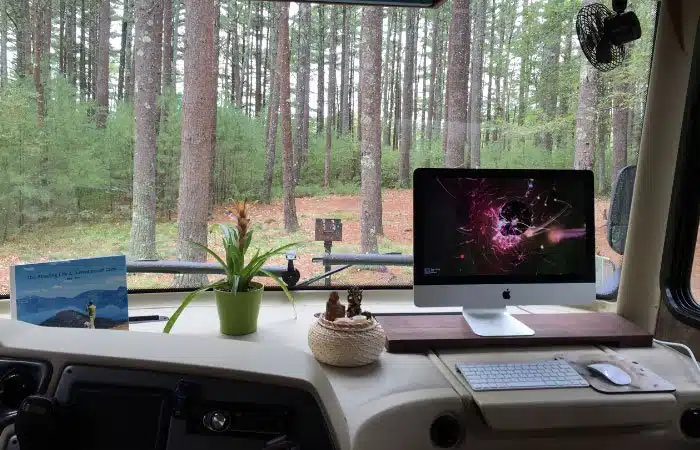
Our campsite at Thousand Trails Gateway to Cape Cod, MA
2015 RV Camping Costs
This was our first full calendar year of RV camping, and we shared the full year of expenses in this 2015 snapshot infographic. We bought one of those state sticker maps to stick on the side of our RV. But be warned. They are addictive!
We drove 8,400 miles in the RV and 8,500 miles in our MINI, visiting 33 states. Our travels went from San Diego in southern California all the way up to Maine in the northeast. Then we headed south to finish up the year in Miami, Florida.
Here’s the breakdown of how and where we camped:
- 189 nights at Thousand Trails Campgrounds
- 123 nights at private RV parks and campgrounds
- 33 nights at public campgrounds (national and state parks)
- 20 nights of boondocking (BLM land, Walmart, rest stops, a restaurant, casinos, and mooch docking with friends.)
- 189 nights at Thousand Trails Campgrounds
TOTAL: $6,360* spent on RV camping over 365 days
* Includes $596.24 in TT annual dues, RPI add-on $159, CO State Parks Annual Pass $70
AVERAGE NIGHTLY FEE: $17.42 per night
Summary:
This was a big year of domestic RV travel exploring North America. We did no other travel (air/cruise/hotel), and we continued to make good use of our Thousand Trails membership, spending more than half the year (189 nights) in TT campgrounds. We also signed up for RPI (Resort Parks International) as an add-on to our Thousand Trails membership.
However, we did not renew Harvest Hosts or Boondockers Welcome in 2015 as we did not plan on using them. Our travels included visiting more national and state parks but still not many, as internet coverage remained a high priority due to Marc’s job.
We tried boondocking for the first time, doing a 9-day boondocking adventure in the southwest (Yuma, Quartzsite, and Lake Havasu). That trip is documented in detail, in our blog series, with prep, costs, and usage. We also walked across the border into Mexico for a dental visit. Our travel map filled up quite nicely in 2015. Many of the northeast states are small, so you can cover a lot quickly.
Read all of our boondocking articles
See where and when we stayed here – click the 2015 tab for details
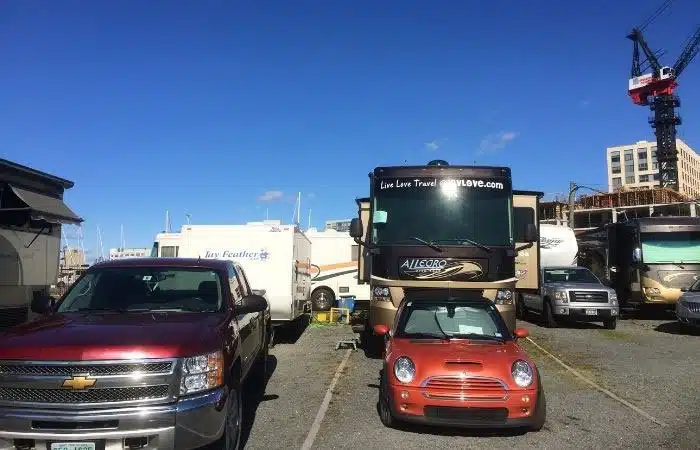
RV camping at Liberty Harbor RV by New York City was more like a parking lot @ $100 a night!
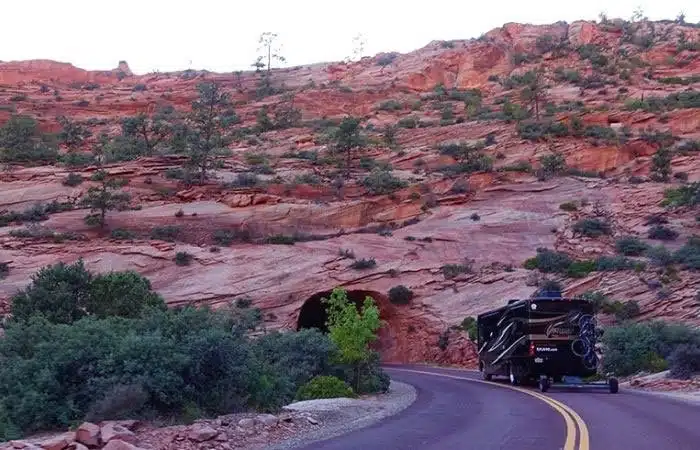
Driving through a tunnel in Zion National Park, Utah to stay at Watchman Campground
2016 RV Camping Costs
Our second full year of RV camping was one of natural beauty overload! We visited several of the most popular national parks – Bryce Canyon, Zion, Capitol Reef, Glacier, and Yellowstone. We also stayed in several state parks in Colorado, Florida, Idaho, and New Mexico.
It nearly completed our state sticker map with 48 states (the last was Idaho). We also mixed up our travels by jetting off to Australia for a month in March-April to visit family while still working (in the opposite timezone). Then in December, we flew to Hawaii for a 10-day hotel vacation. All up, we spent 321 days in our RV, driving about 9,500 miles each in our RV and MINI (a total of 19,000 miles for the year) and visiting 24 states along the way.
Here’s the breakdown:
- 123 nights in private RV parks and campgrounds (inc. 19 nights @ RPI parks)
- 90 nights in Thousand Trails campgrounds
- 74 nights in public campgrounds (national, state, and city parks)
- 20 nights of boondocking (BLM land, Walmart 10 nights, truck stops, rest stops, Cabelas, mooch docking)
- 13 nights @ Albuquerque Int’l Balloon Fiesta (paid event, RV boondocking)
- Total of 320 nights of RV camping
- Other travel was 46 nights (overseas, hotels, RV in storage/repair shop)
- 123 nights in private RV parks and campgrounds (inc. 19 nights @ RPI parks)
TOTAL: $8,077* spent on RV camping over 320 days
* Includes $566 in TT annual dues, plus $159 for RPI
AVERAGE NIGHTLY FEE: $25.24 per night
Summary:
In 2016, we spent only a quarter of the year staying in Thousand Trails campgrounds. Partly because we visited many states in the middle of the country where Thousand Trails doesn’t have much of a presence. We spent just over a month boondocking, including overnights at Walmart, plus 13 nights at the Albuquerque International Balloon Fiesta.
Around 60% of our RV camping stays were at private RV parks and campgrounds. Many were in or near national parks and state parks. As you can see, we paid the price! But we didn’t mind. Our goal is not to RV on the cheap ALL the time. But to travel as far and wide as we can, as affordably as we can, while still having the kinds of experiences we want.
This was probably our most amazing year of travel, as we also did 26,000 air miles. We spent 16 nights RV camping inside three national park campgrounds (Grand Canyon North Rim, Zion, and Yellowstone). And also two weeks at a private RV park near Glacier National Park. We also stayed at state parks in Colorado, Florida, Idaho, and New Mexico. See our 2016 infographic for more RV-related expenses.
Our RPI camping membership was used for stays in South Dakota and Montana. We made sure to visit North Dakota, so we wouldn’t be one of ‘those RVers’ who had visited every state except ND!
See where and when we stayed here – click the 2016 tab for details
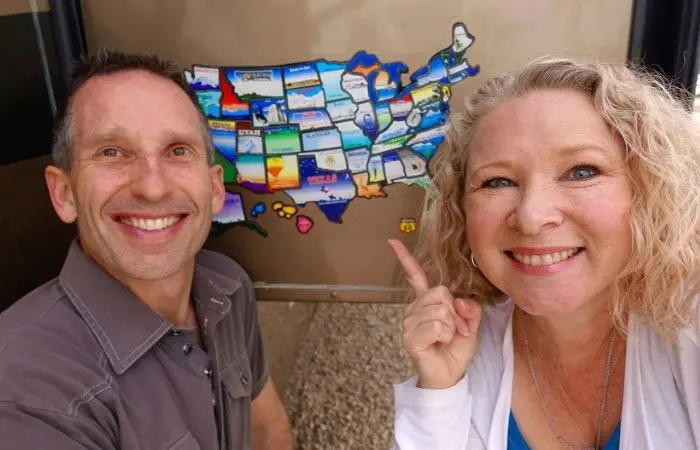
In 2017, we completed our state sticker map with all 50 states
2017 RV Camping Costs
We drove 9,210 miles in the RV, about 8,000 miles in our MINI and Jeep (we changed tow vehicles in October 2017), and visited 17 states. This was also the year we visited our 50th state – Alaska!
Yes, we know it’s the 49th state, but it was the 50th state we visited. Though it was not in our RV. We managed to snag a cheap $399 last-minute cruise to Seward, Alaska, to celebrate this milestone. We had active memberships with Thousand Trails, Passport America, and Harvest Hosts.
Here’s the breakdown of how and where we camped:
- 147 nights at Thousand Trails Campgrounds
- 83 nights at private campgrounds
- 49 nights of boondocking (BLM and National Forest (36), Harvest Hosts (2), Walmart, truck stops, mooch docking
- 18 nights at RV rally events – Xscapers Total Solar Eclipse (5) and FMCA Convention (6) – both paid boondocking; Escapees Escapade (7).
- Ten nights in public campgrounds (national, state, etc)
- Total of 307 nights of RV camping
- Plus 58 nights of RV storage/staying with friends (Alaska cruise, flying trip to Indiana for 14 RV factory tours, Colorado visit)
TOTAL: $4,179 spent on RV camping over 307 days
* Includes $566 in TT annual dues, plus $159 for RPI and $44 for Passport America
AVERAGE NIGHTLY FEE: $13.61 per night
Summary:
We spent a full month at the private park, Oasis Las Vegas RV resort, while preparing to launch our RV Success School. We also spent 5+ weeks in Colorado, which tends to be a very popular state (and often more expensive) for RV camping.
Four RV rally events – Xscapers Convergence in Quartzsite, Escapees Escapade, an FMCA Convention, plus the Total Solar Eclipse with the Xscapers Group. We used our Passport America membership for a total of 7 nights (saving 50% a night). During our Alaska visit, we even paid $200 for a one-day car rental in Skagway, Alaska.
That was so that we could drive through the Yukon and visit the “Welcome to Alaska” sign to take this photo below. Yes, it was worth it! With all 50 stickers on our state sticker map and 3.5 years of RVing behind us, we began slowing our travel pace.
See where and when we stayed here – click the 2017 tab for details.
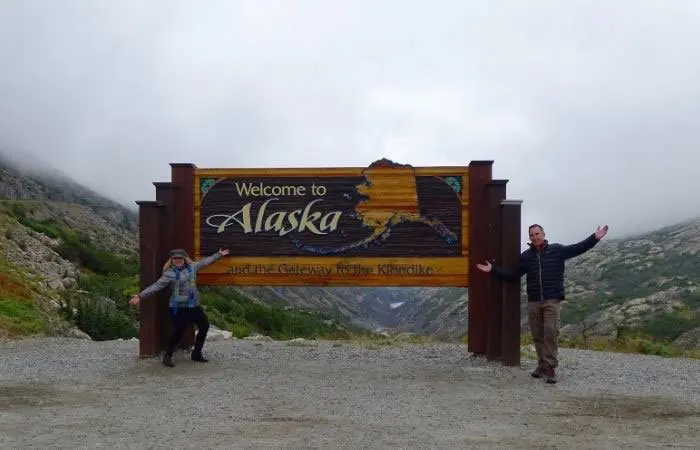
Alaska was our 50th state visited via cruise. We rented a car for $200 just to get this photo.
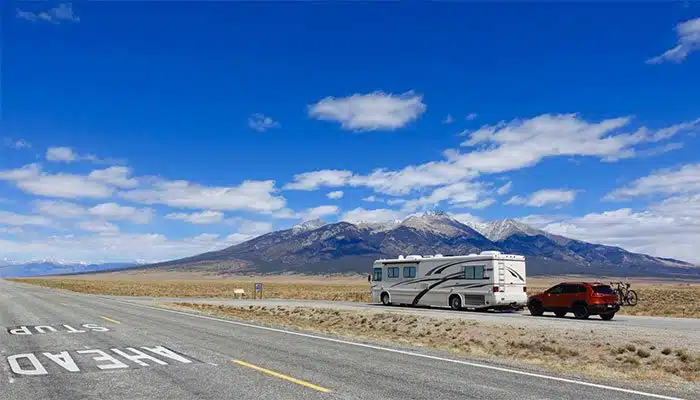
Parked outside the Great Sand Dunes of Colorado in our Class A diesel pusher motorhome
2018 RV Camping Costs
In March 2018, we changed from a gas motorhome to a diesel. All up, we drove around 10,738 miles between both our RVs plus about 11,000 miles in our Jeep. We upgraded our RV battery / solar system and began boondocking a lot more.
2018 ended up being a year mostly focused on work projects. We hunkered down to write and publish our book, among other things. But we still ended up with quite a few travel adventures. We visited 15 states (Texas, New Mexico, and Colorado multiple times) which we covered in our 2018 travel montage video and blog post.
Here’s the breakdown of how and where we camped:
- 120 nights in Thousand Trails
- 113 nights of boondocking (7 weeks mooch docking on our friends Oregon Airbnb property doing our RV Makeover; 45 nights at some Texas Fairgrounds while working on a project, some other BLM stays, and a couple of nights on other friends property
- 79 nights at private campgrounds and RV parks
- 36 nights at public campgrounds (national and state parks)
- Total of 348 nights of RV camping
- Plus 17 nights at RV repair centers (9) or RV storage during other travels (8)
TOTAL: $3,772 spent on RV camping over 348 days
AVERAGE NIGHTLY FEE: $10.84 per night
Summary:
After a big and expensive RV camping year in 2017, we balanced it out in 2018 with much lower RV camping expenses. We spent a lot of time in Texas, where our camping fees expenses were low. And we also spent about four months (about a third of the year) in Thousand Trails campgrounds.
You will notice we almost doubled the number of nights we spent boondocking in 2018 after having our off-grid system installed in May. We spent seven weeks mooch docking (off-grid in terms of power) in the summer on our friends’ awesome Airbnb property while doing our Ultimate RV Makeover.
We spent about two-thirds of the year either boondocking or at Thousand Trails. You can start to see how much that combination was saving us. Our average nightly camping fee was only around $10 a night. Active memberships: Thousand Trails and Passport America.
See our blog post and video on Powering of Our Off Grid RV Renovation
See where and when we stayed here – click the 2018 tab for details
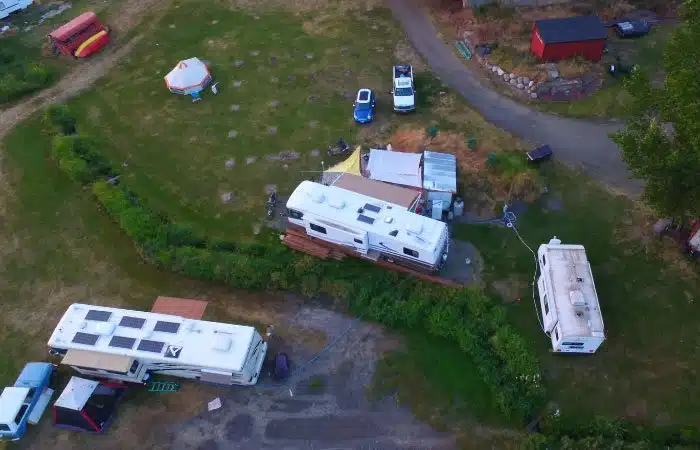
That’s us bottom left, boondocking on our friend’s property while doing our RV Makeover
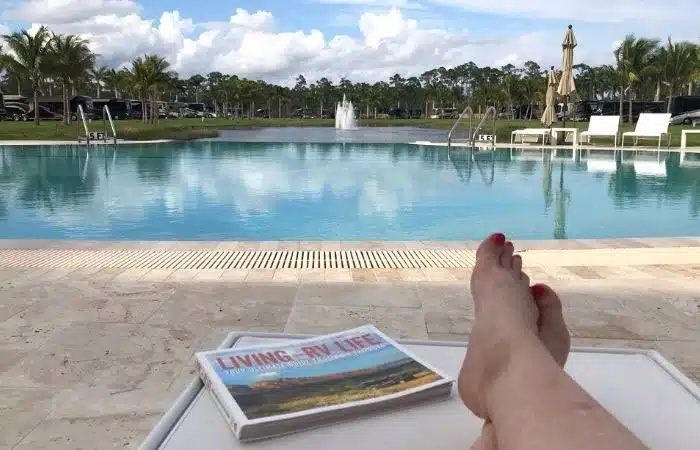
Occasionally we like to live it up at upscale RV resorts like Palm Beach Motorcoach Resort, FL
2019 RV Camping Costs
This year looked pretty similar to the one before regarding miles and camping style. But it was our least expensive. We drove around 10,300 miles in our RV but did a lot more exploring. We visited 25 USA states and drove the RV up into Canada on our way from Maine to Oregon, traveling through two Canadian provinces (Quebec and Ontario) along the way.
Here’s the breakdown of where we stayed:
- 129 nights in Thousand Trails campgrounds
- 70 nights at private RV parks and campgrounds
- 20 nights at public campgrounds (national and state parks)
- 90 nights of boondocking (BLM, Walmarts, rest stops, and 50 nights parked at friends’ properties. Those included in Oregon for more RV mods and upgrades (35), plus 15 in GA, NH, NJ, NV, and WA
- 20 nights staying at RV shows, events, and rallies
- Total of 329 nights of RV camping
- 36 nights in RV storage (trip to Australia, flying visits to Denver and Boston)
TOTAL: $3,278 spent on RV camping over 329 days
AVERAGE NIGHTLY FEE: $9.96 per night
Summary:
2019 was our cheapest year of RV camping to date. Putting several of our camping memberships to good use saved us quite a bit. We spent over four months RV camping in Thousand Trails campgrounds. And our few stays at Passport America and Harvest Hosts locations more than covered the price of membership.
We also spent about three months boondocking. About half of that was mooch docking on friends’ properties. The rest was at RV shows and Walmarts while crossing the country. By now, we were really comfortable with our off-grid system and enjoying the freedom of being able to boondock a lot more often.
See where and when we stayed here – click the 2019 tab for details
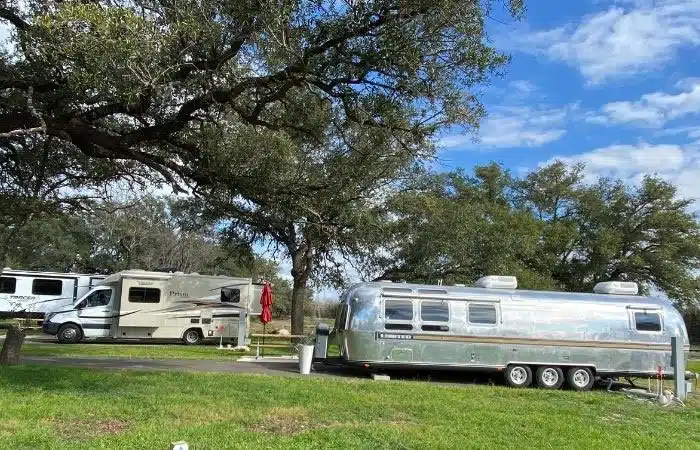
RV camping at Open Air Resorts in Spicewood Texas which also has vintage Airstreams for rent
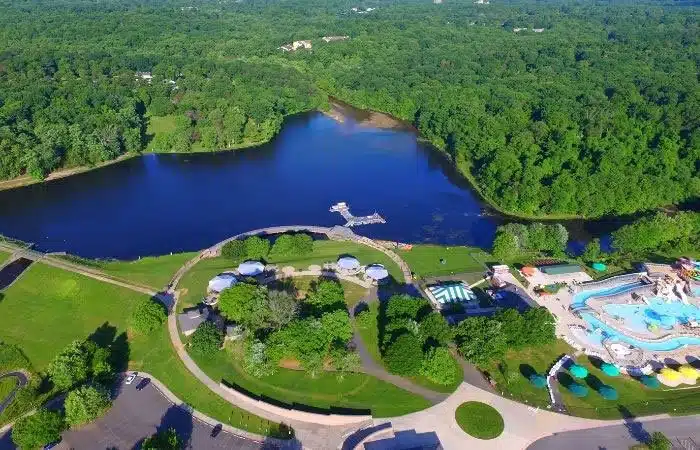
We stayed at Lake Fairfax Park in Reston, Virginia which had RV campsites and a water park
2020 RV Camping Costs (January – June)
We’ve only included our camping costs until the end of June – our 6-year on-the-road-iversary. Obviously, 2020 was an unusual year for everyone, and so our RV camping style and expenses are reflective of that.
In the first half of 2020, we spent four weeks traveling in rental RVs. One RV rental in Florida and another in Texas, traveling around 2,300 miles (pre-pandemic). And we drove just 1,524 miles in our Class A motorhome “CC” for a combined total of 3,824 RV miles, plus a low 600 miles in our Jeep.
Technically, we visited seven states, but only RV camped in five (AZ, CO, FL, NM, TX). The pandemic significantly slowed our travels in 2020. We intentionally maintained a very slow pace to reduce exposure and risk.
Here’s the breakdown of where we stayed:
- 56 nights of boondocking (mostly Arizona BLM, Walmart, and a couple of roadside pullouts). Plus, two nights in Florida Water Management areas in our Florida rental RV and one night on the beach in Texas
- 16 nights at Thousand Trails
- 92 at private RV parks and campgrounds
- Six nights in state parks and city parks
- Two nights at RV repair centers
- Total of 176 nights of RV camping
- Ten nights staying with friends/at hotels/Airbnb (while RV was in for repair)
*TOTAL VALUE OF CAMPING: Around $3,500
*AVERAGE NIGHTLY FEE: $19.88 per night
* In 2020, we did some projects and book signing events that may have also provided a discounted or comped RV stay. The numbers above reflect the total of what we actually paid for our 2020 RV camping ($800) PLUS the retail value of discounted/comped stays to provide a realistic picture of what the total camping costs would be. Our actual average cost for RV camping in 2020 was $4.55 per night.
Summary:
2020 was an atypical year for multiple reasons, and our RV camping expenses are indicative of that. If there is one thing we have learned from our life on the road, it’s to be prepared for the unexpected! We started our RV travel year strong – with a 34-day trip via airplanes, a borrowed van, the Florida RV Supershow, plus a couple of RV rentals – in Florida and Texas. Then, like everyone else, our travels came to a halt in mid-March with the pandemic.
We really made the most of our off-grid system, with about a third of the time spent boondocking, mostly on Arizona BLM land. We put our water conservation skills to the test in the desert. Our longest stay without breaking camp was 20 days. We could have gone longer, but we made a sprint to Colorado for cooler temps. Our longest RV campground stay ever in our six years of full-time RV travel was at a private RV park, Garden of the Gods RV Resort in Colorado. We ended up spending 10.5 weeks there. It was also where we hosted our first Hit the Road RV Summit virtual event.
We spent very little time in Thousand Trails campgrounds that year. Choosing instead to spend extended time in Colorado so that we could be near family. Thousand Trails did not have any locations in Colorado then. But they now have Blue Mesa Recreational Ranch. Having done so much travel since 2014, we were actually quite happy to be taking a bit of a break to catch our breath and take it a bit easier, with a much slower pace.
See where and when we stayed here – click the 2020 tab for details.
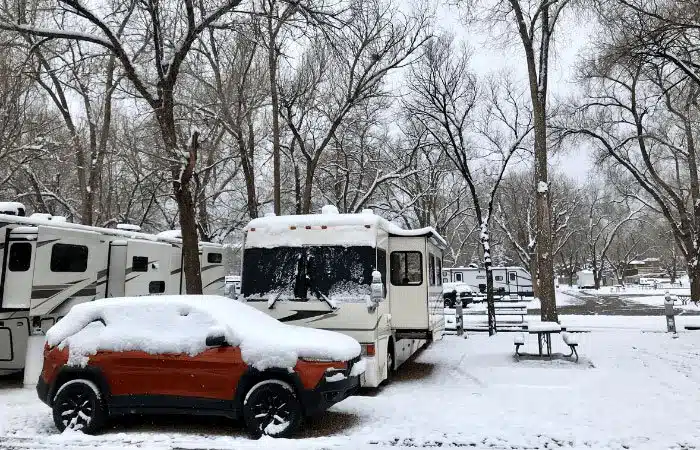
Our longest ever RV stay while sheltering in place @ Garden of the Gods RV Resort, Colorado
Final Overview and Comments
As you can see, our RV camping expenses have ebbed and flowed over the years, depending on our destinations, travel pace, and style. This is why it’s great that this 6-year overview gives a more comprehensive sense of how much (or little) RV camping can cost. It all depends on the variables we listed at the beginning of this article.
When considering what your RV camping budget might be, do keep in mind that:
- Prices change – many campground memberships and nightly camping fees have increased over the years
- As RVing becomes more popular, securing campground reservations – especially in the always popular national and state parks – is becoming more difficult (but not impossible)
- Patience and flexibility, as always, remain key
- How, where, and when YOU stay in your RV will significantly impact the cost
- Camping memberships ( Thousand Trails especially) can save you a lot of money IF you use them
- Boondocking can also save you a lot of money, and you can spend as much or as little as you want on an off-grid system
- Boondocking spots are becoming harder to find, too. With many places becoming more popular and easier to find through online resources. Plus many National Forest and BLM lands being closed due to the pandemic, people disrespecting rules and poor camping behavior.
Finally, RV travel – and especially extended full time RV travel, as we have been doing since 2014 – is absolutely do-able and affordable IF you want it to be. Be smart and strategic about it to suit your preferred travel style and needs.
Happy trails!
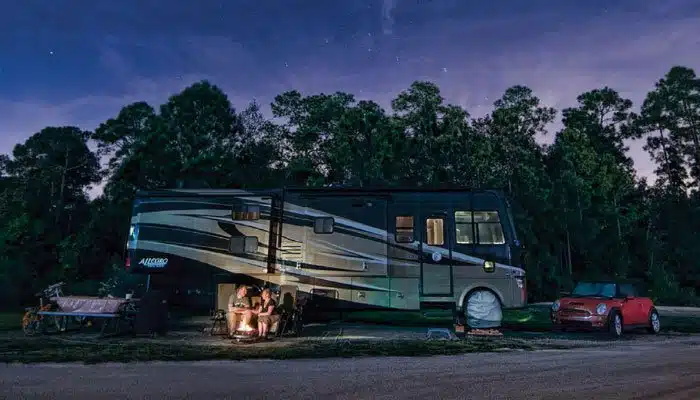
Staying at Thousand Trails Orlando, Florida in the winter. Photo credit: Jerome Braga
Recommended Resources
Ready to plan your own RV adventures? You can find more useful RV camping and trip planning resources listed below:
- We use RV Trip Wizard to plan our RV travel routes
- Discover all RVLove campground reviews here
- Find our RVLove TT campground reviews here
- Search for more campgrounds and reviews at: RVLIFE app, Campground Reviews, Campendium, Campground Views, The Dyrt
- Visit our “Where Have We Been” page for more detail on our stays
GOT COMMENTS OR QUESTIONS?
We would love to hear from you. Drop us a note in the comments section below.
Campground Reviews
Here are a handful of the many campground reviews of places we’ve stayed over the years. Hover over each image to see the title and episode name.
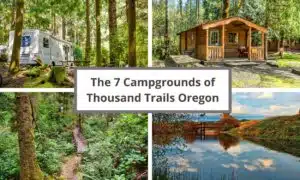
All About Thousand Trails Oregon: 7 Campgrounds
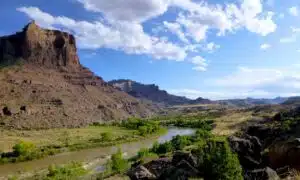
RV Parks Near Green River Utah – Summary and Guide
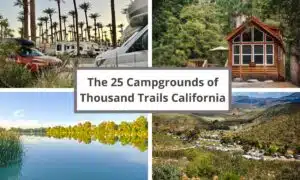
All About Thousand Trails In California: 25 RV parks
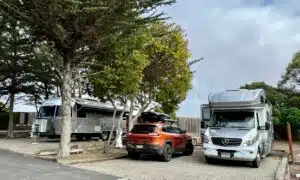
Marina Dunes RV Resort near Monterey California
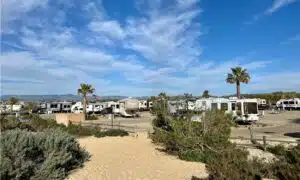
Pacific Dunes Ranch Campground Pismo Beach, CA

Jojoba Hills SKP RV Resort Near Temecula California
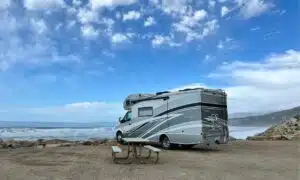
Beachfront RV Camping Near Ventura California
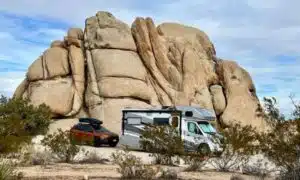
Joshua Tree National Park Belle Campground Review
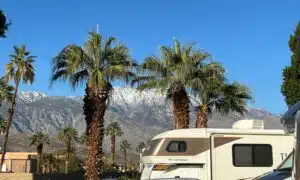
Palm Springs Oasis RV Resort in California
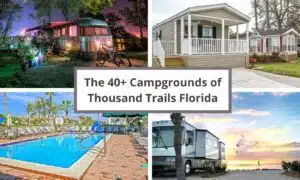
All About Thousand Trails In Florida: 40+ Campgrounds

Fun N Sun RV Resort in Southern Texas Thousand Trails
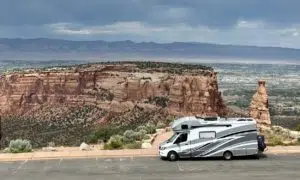
Saddlehorn Campground Review in Colorado
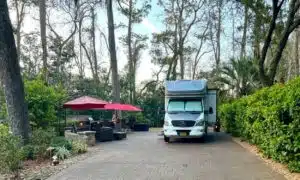
RV at Hilton Head Island Motorcoach Resort In South Carolina
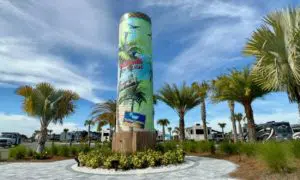
Camp Margaritaville RV Resort Auburndale, Florida
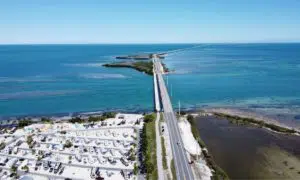

12 thoughts on “RV Camping Costs over 6 years of Full-Time RVing”
Thanks for your continued support for our RV Community
Thank you.
During the summer we always head west from our stick & brick in Pensacola. We generally end up in the Tetons where we spend a month or so in the National Park, which can be dry camping or 50amps only….with central water and dump. You know what that costs with the Geezer pass. In any event the cost is embarrasing. Sometimes we spend a week or so in West Yellowstone at Grizzly (that is expensive). Every summer we spend 2-weeks in Cheyenne, WY for their Frontier Days Rodeo but we stay on the Air Force Base mostly in a FHU site but sometimes a bit of dry camping. When traveling to destinations we stay in a variety of places, commercial campgrounds, Casinos when no AC is needed, Wal Marts when no AC is needed, free city parks and cheap city parks. We have been at this game for some time so we know where these free city parks are. Passport America parks are also at the top of my list and you know what these cost. We also take advantage of some state parks and always a COE park if one is nearby. We pay the big bucks to stay in a good campground when in Cody, WY and in Custer, SD. We always do Custer during the Sturgis Bike Week. We avoid KOA’s if at all possible. The only membership camping we do is with Passport America. If you are interested I have cost data all the way back to 2001 when we started our 6-mos each year experience.
Hi Mike, Thanks for sharing your experiences and how you travel to manage costs. After 19 years of part time RVing, I am sure you have found some favorite gems. -M
You did a great job of breaking your cost down….and of course the record keeping that is required to put together this analysis. While not full-time we are on the road 6-mos a year. Unlike you we do not need high speed internet for anything. Our Verizon MIFI connection and two cellphone hot spots is fine for us. While I am NOT going to go through the past 20-years of this our experience and expenses have mirrored yours. Being retired we are strictly doing this for pleasure. However, both of us are seasoned RV’ers and know how to dry camp. The only thing we seem to do the same is spend part of Dec, all of Jan & Feb in Key West (on the Navy Base). For around 8-years that was dry camping with a central dump station & water supply. That started out at $15 a night, switched to $17 a night and currently it is $22 a night. But this is Key West during the winter and you know what Boyd’s charges plus, we can walk to town from the campground which is priceless. Now the Navy changed things…don’t they always. They have around 90 FHU sites, with around 500 dry camping sites. They give you an option to ROTATE into a FHU site for 14-days…..only around 150 of the dry campers opt for this ROTATION. When you arrive you go to dry camping and get on a list for a FHU site. When your name gets to the top of the list you get to go into FHU which is $30 a night. During our 2&1/2 month stay we end us staying in FHU around 6-weeks. The rest is dry camping. I will share more in another comment.
Hi Mike, Thanks for sharing the detail of your stays. Yes, the Navy base in Key West is a HUGE asset for those who have access. Absolutely amazing to be able to stay in that location (better than any paid campground, but at the unbelievably low prices you mentioned. Our last stay at Boyds was something like $130/night… not $30. 🙂 Thanks again. -M
How much was gassl
Hello Josie, We will be sharing a TON more detail about other RV related expenses in an upcoming article. But will give you the big picture on fuel costs. Over the last six years, we averaged under $400 per month on fuel (combined expense of RV and towed vehicle) Keep an eye out for the follow up details in the coming weeks. -M
What about the cost of the RV, depreciation should be included.
Hello Terry. Yes, we totally agree and have written up super detailed blogs with all RV related expenses including depreciation, repairs, upgrades, financing, fuel and more. Looking forward to sharing with you soon. Just refining details and reformatting to post onto the website. Sorry it is taking a while. Taking a lot of effort to compile all this. -M
On your Australian trip in 2019 did you rent an RV and tour the East coast? I have put together a budgetary plan to fly to Darwin take the train through central Australia to Adelaide. Rent a RV and travel up the east coast to Cairns, back to Sydney and fly home. I don’t have immediate plans to do this but would be interested in seeing your trip.
We have been to 49 states(no Hawii) plus all Canadian provinces except Saskatchewan and Manitoba.
Gary Rightmire
email [email protected]
Hi Gary. Sounds like you have done a lot of great travel here in the USA. As for our multiple trips to Australia, Julie and I have actually not rented (or even borrowed) RVs in Australia yet. We have some friends and family who have them, but all of our trips so far we have been staying with friends, family, or in hotels and airBNBs. We actually planned a trip this fall where we planned to do quite a bit of RVing, but Covid restrictions cancelled the trip. Hope you have an awesome time when restrictions are lifted and you can do the trip you have planned. RVing in Australia is definitely different than here. The infrastructure for RVing, and the RVs themselves are quite different. -M